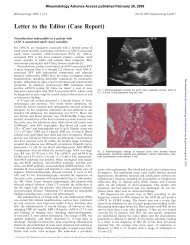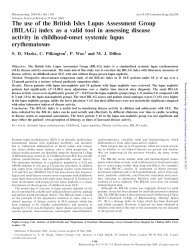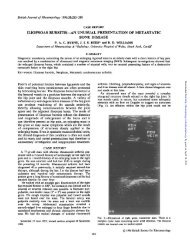radiological outcome in ankylosing spondylitis - Rheumatology
radiological outcome in ankylosing spondylitis - Rheumatology
radiological outcome in ankylosing spondylitis - Rheumatology
You also want an ePaper? Increase the reach of your titles
YUMPU automatically turns print PDFs into web optimized ePapers that Google loves.
British Journal of <strong>Rheumatology</strong> 1996;35:373-376<br />
RADIOLOGICAL OUTCOME IN ANKYLOSING SPONDYLITIS: USE OF<br />
THE STOKE ANKYLOSING SPONDYLITIS SPINE SCORE (SASSS)<br />
H. L. AVERNS, J. OXTOBY,* H. G. TAYLOR,t P. W. JONES,J K. DZDEDZIC and P. T. DA WES<br />
Staffordshire <strong>Rheumatology</strong> Centre, The Haywood, Stoke on Trent, 'Department of Radiology, North Staffs Royal<br />
Infirmary, t<strong>Rheumatology</strong> Department, Wanganui Hospital, New Zealand and \Department of Mathematics,<br />
Keele University<br />
SUMMARY<br />
We <strong>in</strong>vestigated the role of the Stoke Ankylos<strong>in</strong>g Spondylitis Sp<strong>in</strong>e Score (SASSS) <strong>in</strong> a longitud<strong>in</strong>al cohort study of 53 patients<br />
with AS, assessed 9 yr apart, and its relation to cl<strong>in</strong>ical, functional and laboratory measures of disease activity and <strong>outcome</strong>.<br />
We also exam<strong>in</strong>ed the long-term predictive value of quantitative sacroiliac sc<strong>in</strong>tigraphy (QSS). SASSS correlated closely with<br />
cl<strong>in</strong>ical measures, <strong>in</strong>clud<strong>in</strong>g occiput-wall distance (OWD) (P < 0.001) and modified Schober (P < 0.0001). QSS was significantly<br />
correlated with f<strong>in</strong>al X-ray score (P < 0.05). SASSS changed significantly (P < 0.001) over the study period; two patterns of<br />
change <strong>in</strong> sp<strong>in</strong>e score were discernible, one with little change <strong>in</strong> <strong>radiological</strong> score and the other show<strong>in</strong>g marked progression.<br />
The SASSS is a useful, valid score, which correlates with cl<strong>in</strong>ical <strong>outcome</strong> measures and which has identified specific patterns<br />
of radiographic progression <strong>in</strong> AS.<br />
KHY WORDS: Ankylos<strong>in</strong>g <strong>spondylitis</strong>, Radiology, Sc<strong>in</strong>tigraphy.<br />
OUTCOME <strong>in</strong> ankylos<strong>in</strong>g <strong>spondylitis</strong> (AS) can be<br />
assessed <strong>in</strong> terms of daily function, pa<strong>in</strong> scores, cl<strong>in</strong>ical<br />
measurements and <strong>radiological</strong> change. There are no<br />
<strong>in</strong>ternationally agreed criteria for the assessment of<br />
disease activity, and <strong>in</strong> the <strong>in</strong>dividual patient it is<br />
difficult to predict who will have favourable or<br />
unfavourable <strong>outcome</strong>s [1, 2]. Thus, identify<strong>in</strong>g useful<br />
predictors of long-term <strong>outcome</strong> is essential,<br />
particularly if disease modification <strong>in</strong> AS becomes a<br />
possibility.<br />
ESR and CRP are not considered useful measures of<br />
activity [3,4], except <strong>in</strong> those with a peripheral<br />
arthritis, but their role <strong>in</strong> predict<strong>in</strong>g long-term <strong>outcome</strong><br />
is unclear, unlike <strong>in</strong> rheumatoid arthritis.<br />
Russell et al. [5] showed that quantitative radioisotope<br />
sacroiliac sc<strong>in</strong>tigraphy (QSS) is sensitive <strong>in</strong> the<br />
diagnosis of sacroiliitis, but other workers felt there<br />
was a large overlap between control and diseased<br />
patients, limit<strong>in</strong>g the role of QSS <strong>in</strong> the rout<strong>in</strong>e<br />
<strong>in</strong>vestigation and management of AS [6]. Assum<strong>in</strong>g<br />
that there is no <strong>in</strong>creased uptake of radionuclide by the<br />
sacrum may be misguided; Paqu<strong>in</strong>. et al. [7] used<br />
lumbar to soft tissue and sacrum to soft tissue ratios,<br />
ref<strong>in</strong><strong>in</strong>g the technique of QSS. No studies have assessed<br />
the long-term predictive value of QSS <strong>in</strong> AS.<br />
In previous work at the Staffordshire <strong>Rheumatology</strong><br />
Centre, we analysed predictors of <strong>radiological</strong> change<br />
over 12 months [8]. We have reviewed the patients<br />
<strong>in</strong>volved <strong>in</strong> this orig<strong>in</strong>al study to identify prognostic<br />
factors <strong>in</strong> <strong>radiological</strong> <strong>outcome</strong> over 9 yr and to<br />
<strong>in</strong>vestigate the value of the lumbar sp<strong>in</strong>e X-ray score.<br />
This study aimed to address the follow<strong>in</strong>g. (1) Does<br />
the Stoke AS Sp<strong>in</strong>e Score (SASSS) correlate with<br />
Submitted 1 August 1995; revised version accepted 30 November<br />
1995.<br />
Correspondence to: H. L. Averns, Stoke Mandeville Hospital,<br />
Mandeville Road, Aylesbury.<br />
373<br />
cl<strong>in</strong>ical measures of axial function and <strong>outcome</strong> <strong>in</strong> AS?<br />
(2) Does QSS have a role <strong>in</strong> predict<strong>in</strong>g long-term<br />
<strong>outcome</strong> <strong>in</strong> AS? (3) Are there any laboratory,<br />
<strong>radiological</strong> or cl<strong>in</strong>ical measurements which predict<br />
<strong>radiological</strong> progression <strong>in</strong> AS?<br />
METHODS<br />
Sixty-one patients with def<strong>in</strong>ite AS (New York<br />
Criteria) who were <strong>in</strong>volved <strong>in</strong> the orig<strong>in</strong>al studies of<br />
the SASSS [8] were followed up for further cl<strong>in</strong>ical,<br />
laboratory and <strong>radiological</strong> assessment. All patients<br />
were assessed by the same exam<strong>in</strong>er (HLA) <strong>in</strong> the early<br />
afternoon. The exam<strong>in</strong>ation <strong>in</strong>cluded the modified<br />
Schober test, total sp<strong>in</strong>e movement from neutral<br />
between the seventh cervical vertebra and the fifth<br />
lumbar vertebra, f<strong>in</strong>ger-floor distance on sagittal<br />
flexion, occiput-wall distance, chest expansion and<br />
Stoke Enthesitis Index [9]. To measure the Enthesitis<br />
Index, various entheses which <strong>in</strong>clude the plantar<br />
fascia, Achilles tendon <strong>in</strong>sertion, greater trochanter,<br />
adductor orig<strong>in</strong>, iliac crest, ischial tuberosity,<br />
sternoclavicular jo<strong>in</strong>t, sternocostal jo<strong>in</strong>ts and the<br />
vertebral processes at four levels are palpated with<br />
enough force to make the thumb blanche. Each<br />
enthesis scores from 0 (no pa<strong>in</strong>) to 3 (withdrawal), the<br />
sum of the scores mak<strong>in</strong>g up the f<strong>in</strong>al enthesitis score.<br />
Patients were asked to record the severity of current<br />
pa<strong>in</strong>, night pa<strong>in</strong> and stiffness on a visual analogue scale<br />
(VAS), and completed a functional <strong>in</strong>dex as described<br />
by Dougados et al. [10]. The functional <strong>in</strong>dex exam<strong>in</strong>es<br />
various activities of daily liv<strong>in</strong>g, such as ability to dress,<br />
to get <strong>in</strong>to a car and to get out of bed, the score be<strong>in</strong>g<br />
proportional to the difficulty perceived by the patient.<br />
Blood was taken for FBC, ESR, CRP, biochemical<br />
profile, osteocalc<strong>in</strong>, immunoglobul<strong>in</strong>s A, G and M, and<br />
a-1-glycoprote<strong>in</strong>. Lateral X-rays of the lumbar sp<strong>in</strong>e<br />
and pelvic X-rays were taken if there had been none<br />
© 1996 British Society for <strong>Rheumatology</strong><br />
Downloaded from<br />
http://rheumatology.oxfordjournals.org/<br />
by guest on March 29, 2013
374 BRITISH JOURNAL OF RHEUMATOLOGY VOL. 35 NO. 4<br />
FIG. 1.—Radiographic scor<strong>in</strong>g system (see the text for details).<br />
performed <strong>in</strong> the previous 12 months. All corners of<br />
each vertebra between the lower border of T12 and the<br />
upper border of SI are exam<strong>in</strong>ed and scored 1 for<br />
erosion, squar<strong>in</strong>g or sclerosis, 2 for syndesmophyte<br />
formation, and 3 for total bony bridg<strong>in</strong>g, giv<strong>in</strong>g a<br />
maximum possible score of 72 (see Fig. 1). In ~ 10%<br />
of films, the upper sacrum is poorly shown on the<br />
lateral lumbar sp<strong>in</strong>e view and a lateral sacral film is<br />
needed <strong>in</strong> order not to compromise the analysis.<br />
Follow<strong>in</strong>g a period of tra<strong>in</strong><strong>in</strong>g, the available X-rays<br />
from the orig<strong>in</strong>al study and all the latest X-rays were<br />
scored <strong>in</strong>dependently by a rheumatologjst and a<br />
radiologist, but for the purpose of this study we<br />
subsequently exam<strong>in</strong>ed each X-ray jo<strong>in</strong>tly to agree on<br />
the f<strong>in</strong>al score. The effective radiation dose of a lateral<br />
lumbar sp<strong>in</strong>e X-ray taken at 80 kVp is 0.205 mSv.<br />
Forty-two patients had had quantitative sacroiliac<br />
sc<strong>in</strong>tigraphy us<strong>in</strong>g 450 mBq Tc-99m-labelled methylose<br />
diphosphonate (MDP) <strong>in</strong> a previous study to assess the<br />
role of isotope scann<strong>in</strong>g <strong>in</strong> the management of AS [11].<br />
Ratios were calculated, <strong>in</strong>clud<strong>in</strong>g sacroiliac: soft tissue<br />
(SIJ:ST) and sacrum:ST.<br />
Statistical analyses were performed with the Number<br />
Cruncher Statistical System 5.01. Spearman's cor-<br />
relation was used to <strong>in</strong>vestigate the relationship of<br />
SASSS with other variables.<br />
RESULTS<br />
We have def<strong>in</strong>ed <strong>in</strong>itial results as time (t) = 0 and the<br />
latest results as t = 1.<br />
Five patients failed to attend the whole study and<br />
three more were reclassified as diffuse idiopathic<br />
skeletal hyperostosis, so 53 patients with def<strong>in</strong>ite AS<br />
were fully assessed. The median age of patients at<br />
follow-up was 47.5 yr (range 32-66) and the median<br />
duration of history was 20 yr (range 9-48). The median<br />
study follow-up time was 9 yr.<br />
Thirty-two patients had def<strong>in</strong>ite syndesmophytes and<br />
21 had no sign of syndesmophytes.<br />
Change <strong>in</strong> SASSS over time<br />
The median total sp<strong>in</strong>e score at / = 0 was 5.5 (range<br />
0-52); 9 yr later the median score was 28.5 (range 0-72)<br />
(P < 0.0001).<br />
Figure 2 shows the <strong>in</strong>ter<strong>in</strong>dividual variation <strong>in</strong><br />
change <strong>in</strong> sp<strong>in</strong>e score, and <strong>in</strong> particular shows that<br />
while <strong>in</strong> some patients there is little change, others<br />
show considerable progression of <strong>radiological</strong> changes<br />
dur<strong>in</strong>g the study period. By choos<strong>in</strong>g an arbitrary value<br />
of 12 to separate the patients <strong>in</strong>to slow and fast<br />
progressors, we were unable to demonstrate any<br />
variable that could predict <strong>outcome</strong>.<br />
Change <strong>in</strong> sp<strong>in</strong>e score was not significantly related to<br />
cl<strong>in</strong>ic attendance, length of history, age of patient or<br />
age at diagnosis.<br />
Relationship between SASSS and cl<strong>in</strong>ical measurements<br />
SASSS was significantly correlated with chest<br />
expansion, occiput-wall distance, f<strong>in</strong>ger-floor distance,<br />
72 -<br />
TIME<br />
FK}. 2.—Change <strong>in</strong> Stoke AS Sp<strong>in</strong>e Score <strong>in</strong> patients with AS<br />
over 9 yr.<br />
Downloaded from<br />
http://rheumatology.oxfordjournals.org/<br />
by guest on March 29, 2013
TABLE I<br />
Correlation (Spearman) between Stoke AS Sp<strong>in</strong>e Score and cl<strong>in</strong>ical<br />
measures<br />
Chest expansion<br />
Occiput-wall distance<br />
F<strong>in</strong>ger-floor distance<br />
Schober test<br />
Total sp<strong>in</strong>al movement<br />
AVERNS ET AL:. USE OF STOKE AS SPINE SCORE 375<br />
r<br />
-0.396<br />
0.503<br />
0.351<br />
-0.690<br />
-0.717<br />
P<br />
< 0.01<br />
< 0.001<br />
376 BRITISH JOURNAL OF RHEUMATOLOGY VOL. 35 NO. 4<br />
scrum immunoglobul<strong>in</strong>s <strong>in</strong> ankylos<strong>in</strong>g <strong>spondylitis</strong>. Ann<br />
Rheum Dis 1983;42:524-8.<br />
4. Sheehan NJ, Slav<strong>in</strong> BM, Donovan MP, Mount JN,<br />
Mathews JA. Lack of correlation between cl<strong>in</strong>ical disease<br />
activity and erythrocyte sedimentation rate, acute phase<br />
prote<strong>in</strong>s or protease <strong>in</strong>hibitors <strong>in</strong> ankylos<strong>in</strong>g <strong>spondylitis</strong>.<br />
Br J Rheumatol 1986;25:171-4.<br />
5. Russell AS, Lentle BC, Percy JS. Investigation of<br />
sacroiliac disease: comparative evaluation of <strong>radiological</strong><br />
and radionuclide techniques. J Rheumatol 1975;2:45—51.<br />
6. Spencer DG, Adams FG, Horton PW, Buchanan WW.<br />
Sc<strong>in</strong>tiscann<strong>in</strong>g <strong>in</strong> ankylos<strong>in</strong>g <strong>spondylitis</strong>: A cl<strong>in</strong>ical,<br />
<strong>radiological</strong>, and quantitative radioisotopic study.<br />
J Rheumatol 1979;6:426-31.<br />
7. Paqu<strong>in</strong> J, Rosenthall L, Esdaile J, Warshawski<br />
R, Damtew B. Elevated uptake of ""technetium<br />
methylene diphosphonate <strong>in</strong> the axial skeleton <strong>in</strong><br />
ankylos<strong>in</strong>g <strong>spondylitis</strong> and Reiter's disease: Implications<br />
for quantitative sacroiliac sc<strong>in</strong>tigraphy. Arthritis Rheum<br />
1983;26:217-20.<br />
8. Taylor HG, Wardle T, Beswick EJ, Dawes PT. The<br />
relationship of cl<strong>in</strong>ical and laboratory measurements to<br />
<strong>radiological</strong> change <strong>in</strong> ankylos<strong>in</strong>g <strong>spondylitis</strong>. Br<br />
J Rheumatol 1991^0:330-5.<br />
9. Dawes PT, Sheeran TP, Beswick EJ, Hothersall TE.<br />
Enthesopathy <strong>in</strong>dex <strong>in</strong> ankylos<strong>in</strong>g <strong>spondylitis</strong>. Ann<br />
Rheum Dis 1987;46:717.<br />
10. Dougados M, Gueguen A, Nakache JP, Nguyen M,<br />
Mery C, Amor B. Evaluation of a functional <strong>in</strong>dex and<br />
an articular <strong>in</strong>dex <strong>in</strong> ankylos<strong>in</strong>g <strong>spondylitis</strong>. J Rheumatol<br />
1988;15:302-7.<br />
11. Taylor HG, Gadd R, Beswick EJ, Venkateswaran M,<br />
Dawes PT. Quantitative radio-isotope scann<strong>in</strong>g <strong>in</strong><br />
ankylos<strong>in</strong>g <strong>spondylitis</strong>: a cl<strong>in</strong>ical, laboratory and<br />
computerised tomographic study. Scand J Rheumatol<br />
1991;2















